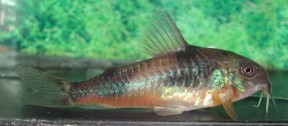Corydoras ehrhardti
SynonymsTop ↑
Corydoras meridionalis Ihering, 1911
Etymology
Corydoras: from the Ancient Greek κόρυς (korus), meaning ‘helmet’, and δορά (dora), meaning ‘skin, hide of an animal’, in allusion to the rows of bony plates on the flanks of genus members.
ehrhardti: named in honour of Mr. W. Ehrhardt.
Classification
Order: Siluriformes Family: Callichthyidae
Distribution
Known from southern Sao Paulo to northern Santa Catarina states in eastern Brazil, including the rios Jaraguá, Iguaçu, Tejuco, Ribeira de Iguape, Guabiroba, Tibagi, Capivari, Lindo, Itapocu, São Pedro, and upper Rio Paranapanema.
Type locality is ‘Affluents from Jaraguá mountains, near Joinville, 26°21’S, 48°49’W, Santa Catarina State, Brazil’.
Habitat
Inhabits minor rivers and small streams with soft substrates, a number of which have been modified by the actions of humans.
Maximum Standard Length
40 – 50 mm.
Maintenance
Ideally use a substrate of fine sand, although rounded gravel is an acceptable alternative provided it’s kept scrupulously clean.
Other décor is largely down to personal choice, but some cover should be provided to give the fish security.
Water Conditions
Temperature: 18 – 23 °C
pH: 6.5 – 7.5
Hardness: 90 – 268 ppm
Diet
Corydoras spp. are foraging omnivores and will accept most sinking dried foods, as well as small live and frozen varieties such as chironomid larvae (bloodworm), Tubifex, etc.
Feeding a varied diet will ensure the fish are in optimum condition.
Under no circumstances should they be expected to survive on ‘left-overs’ from other inhabitants of the aquarium or relied on to ‘clean’ the aquarium.
Behaviour and CompatibilityTop ↑
Peaceful and gregarious. Should be maintained in a group of at least 4-6 individuals.
Sexual Dimorphism
Females tend to grow larger, and sexually mature individuals are noticeably rounder and broader-bodied than males, especially when gravid.
NotesTop ↑
This rarely-traded species is similar in appearance to a number of congeners including C. diphyes, C. carlae, C. garbei, C. lacrimostigmata, C. paleatus and C. steindachneri.
The genus Corydoras is among the largest catfish groups and currently contains over 150 valid species.
It is included in the family Callichthyidae, of which members are often referred to collectively as ‘armoured’ or ‘mailed’ catfishes group due to the presence of bony plates in place of scales on the body.
Their taxonomy can be confusing, and numerous undescribed species are also thought to exist.
Fish of unconfirmed identification entering the aquarium hobby are therefore typically assigned a ‘C‘ or ‘CW‘ number for purposes of reference and organisation.
They are facultative air breathers and possess a modified, highly vascularised intestine which has evolved to facilitate uptake of atmospheric oxygen and aid survival in oxygen-deprived environments. In the aquarium you’ll occasionally see them rising to the surface to take in gulps of air.
The stiffened pectoral-fin spines are capable of piercing human skin and a ‘sting’ can be very painful indeed, so care should be exercised when handling them.
It is thought that secretions from the axillary glands at the base of each spine may even be mildly toxic or venomous.
References
- Steindachner, F., 1910 - Anzeiger der Akademie der Wissenschaften in Wien 47(8): 57-62
Über eine neue Loricaria-Art aus dem Flussgebiete des Jaraguá und der Ribeira im Staate S. Paulo und Sa. Catharina. - Britski, H. A. and A. L. C. Mendonça, 2010 - Papéis Avulsos de Zoologia, São Paulo 50(8): 91-95
Rediscovery of the syntypes of Corydoras meridionalis R. von Ihering, 1911 (Teleostei, Siluriformes, Callichthyidae) and designation of lectotype. - Ferraris, C. J., Jr., 2007 - Zootaxa 1418: 1-628
Checklist of catfishes, recent and fossil (Osteichthyes: Siluriformes), and catalogue of siluriform primary types. - Fuller, I. A. M., and H-G. Evers, 2005 - Verlag A.C.S. GmbH: 1-384
Identifying Corydoradinae Catfish. - Reis, R. E., S. O. Kullander, and C. J. Ferraris, Jr. (eds) , 2003 - EDIPUCRS, Porto Alegre: i-xi + 1-729
Check list of the freshwater fishes of South and Central America. CLOFFSCA.



